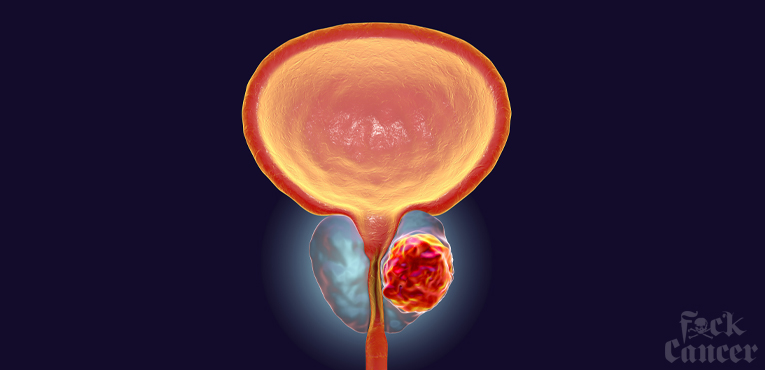
What Is Prostate Cancer?
Prostate cancer begins when cells in the prostate gland start to grow out of control. The prostate is a gland found only in males. It makes some of the fluid that is part of semen.
The prostate is below the bladder (the hollow organ where urine is stored) and in front of the rectum (the last part of the intestines). Just behind the prostate are glands called seminal vesicles that make most of the fluid for semen. The urethra, which is the tube that carries urine and semen out of the body through the penis, goes through the center of the prostate.
The size of the prostate can change as a man ages. In younger men, it is about the size of a walnut, but it can be much larger in older men.
Types of prostate cancer
Almost all prostate cancers are adenocarcinomas. These cancers develop from the gland cells (the cells that make the prostate fluid that is added to the semen).
Other types of cancer that can start in the prostate include:
- Small cell carcinomas
- Neuroendocrine tumors (other than small cell carcinomas)
- Transitional cell carcinomas
- Sarcomas
These other types of prostate cancer are rare. If you are told you have prostate cancer, it is almost certain to be an adenocarcinoma.
Some prostate cancers grow and spread quickly, but most grow slowly. In fact, autopsy studies show that many older men (and even some younger men) who died of other causes also had prostate cancer that never affected them during their lives. In many cases, neither they nor their doctors even knew they had it.
Possible pre-cancerous conditions of the prostate
Some research suggests that prostate cancer starts out as a pre-cancerous condition, although this is not yet known for sure. These conditions are sometimes found when a man has a prostate biopsy (removal of small pieces of the prostate to look for cancer).
Prostatic intraepithelial neoplasia (PIN)
In PIN, there are changes in how the prostate gland cells look when seen with a microscope, but the abnormal cells don’t look like they are growing into other parts of the prostate (like cancer cells would). Based on how abnormal the patterns of cells look, they are classified as:
- Low-grade PIN: The patterns of prostate cells appear almost normal.
- High-grade PIN: The patterns of cells look more abnormal.
Low-grade PIN is not thought to be related to a man’s risk of prostate cancer. On the other hand, high-grade PIN is thought to be a possible precursor to prostate cancer. If you have a prostate biopsy and high-grade PIN is found, there is a greater chance that you might develop prostate cancer over time.
PIN begins to appear in the prostates of some men as early as in their 20s. But many men with PIN will never develop prostate cancer.
Proliferative inflammatory atrophy (PIA)
In PIA, the prostate cells look smaller than normal, and there are signs of inflammation in the area. PIA is not cancer, but researchers believe that PIA may sometimes lead to high-grade PIN, or perhaps directly to prostate cancer.
Prostate Cancer Risk Factors
A risk factor is anything that raises your risk of getting a disease such as cancer. Different cancers have different risk factors. Some risk factors, like smoking, can be changed. Others, like a person’s age or family history, can’t be changed.
But having a risk factor, or even several, does not mean that you will get the disease. Many people with one or more risk factors never get cancer, while others who get cancer may have had few or no known risk factors.
Researchers have found several factors that might affect a man’s risk of getting prostate cancer.
- Age – Prostate cancer is rare in men younger than 40, but the chance of having prostate cancer rises rapidly after age 50. About 6 in 10 cases of prostate cancer are found in men older than 65.
- Race/ethnicity – Prostate cancer develops more often in African-American men and in Caribbean men of African ancestry than in men of other races. And when it does develop in these men, they tend to be younger. Prostate cancer occurs less often in Asian-American and Hispanic/Latino men than in non-Hispanic whites. The reasons for these racial and ethnic differences are not clear.
- Geography – Prostate cancer is most common in North America, northwestern Europe, Australia, and on Caribbean islands. It is less common in Asia, Africa, Central America, and South America.
- The reasons for this are not clear. More intensive screening for prostate cancer in some developed countries probably accounts for at least part of this difference, but other factors such as lifestyle differences (diet, etc.) are likely to be important as well. For example, Asian Americans have a lower risk of prostate cancer than white Americans, but their risk is higher than that of men of similar ethnic backgrounds living in Asia.
- Family history – Prostate cancer seems to run in some families, which suggests that in some cases there may be an inherited or genetic factor. Still, most prostate cancers occur in men without a family history of it. Having a father or brother with prostate cancer more than doubles a man’s risk of developing this disease. (The risk is higher for men who have a brother with the disease than for those who have a father with it.) The risk is much higher for men with several affected relatives, particularly if their relatives were young when the cancer was found.
- Gene changes – Several inherited gene changes (mutations) seem to raise prostate cancer risk, but they probably account for only a small percentage of cases overall.
Factors with less clear effects on prostate cancer risk
- Diet – The exact role of diet in prostate cancer is not clear, but several factors have been studied. Men who eat a lot of dairy products appear to have a slightly higher chance of getting prostate cancer. Some studies have suggested that men who consume a lot of calcium (through food or supplements) may have a higher risk of developing prostate cancer. But most studies have not found such a link with the levels of calcium found in the average diet, and it’s important to note that calcium is known to have other important health benefits.
- Obesity – Being obese (very overweight) does not seem to increase the overall risk of getting prostate cancer. Some studies have found that obese men have a lower risk of getting a low-grade (slower growing) form of the disease, but a higher risk of getting more aggressive (faster growing) prostate cancer. The reasons for this are not clear. Some studies have also found that obese men may be at greater risk for having more advanced prostate cancer and of dying from prostate cancer, but not all studies have found this.
- Smoking – Most studies have not found a link between smoking and getting prostate cancer. Some research has linked smoking to a possible small increased risk of dying from prostate cancer, but this finding needs to be confirmed by other studies.
- Chemical exposures – There is some evidence that firefighters can be exposed to chemicals that may increase their risk of prostate cancer. A few studies have suggested a possible link between exposure to Agent Orange, a chemical used widely during the Vietnam War, and the risk of prostate cancer, although not all studies have found such a link. The National Academy of Medicine considers there to be “limited/suggestive evidence” of a link between Agent Orange exposure and prostate cancer. To learn more, see Agent Orange and Cancer.
- Inflammation of the prostate – Some studies have suggested that prostatitis (inflammation of the prostate gland) may be linked to an increased risk of prostate cancer, but other studies have not found such a link. Inflammation is often seen in samples of prostate tissue that also contain cancer. The link between the two is not yet clear, and this is an active area of research.
- Sexually transmitted infections – Researchers have looked to see if sexually transmitted infections (like gonorrhea or chlamydia) might increase the risk of prostate cancer, because they can lead to inflammation of the prostate. So far, studies have not agreed, and no firm conclusions have been reached.
- Vasectomy – Some studies have suggested that men who have had a vasectomy (minor surgery to make men infertile) have a slightly increased risk for prostate cancer, but other studies have not found this. Research on this possible link is still under way.
Key Statistics for Prostate Cancer
How common is prostate cancer?
Other than skin cancer, prostate cancer is the most common cancer in American men. The American Cancer Society’s estimates for prostate cancer in the United States for 2020 are:
- About 191,930 new cases of prostate cancer
- About 33,330 deaths from prostate cancer
Risk of prostate cancer
About 1 man in 9 will be diagnosed with prostate cancer during his lifetime.
Prostate cancer is more likely to develop in older men and in African-American men. About 6 cases in 10 are diagnosed in men who are 65 or older, and it is rare in men under 40. The average age at diagnosis is about 66.
Deaths from prostate cancer
Prostate cancer is the second leading cause of cancer death in American men, behind only lung cancer. About 1 man in 41 will die of prostate cancer.
Prostate cancer can be a serious disease, but most men diagnosed with prostate cancer do not die from it. In fact, more than 3.1 million men in the United States who have been diagnosed with prostate cancer at some point are still alive today.
Sources: www.stepup.pcf.org, www.postatehealthguide.com, www.cancer.org
